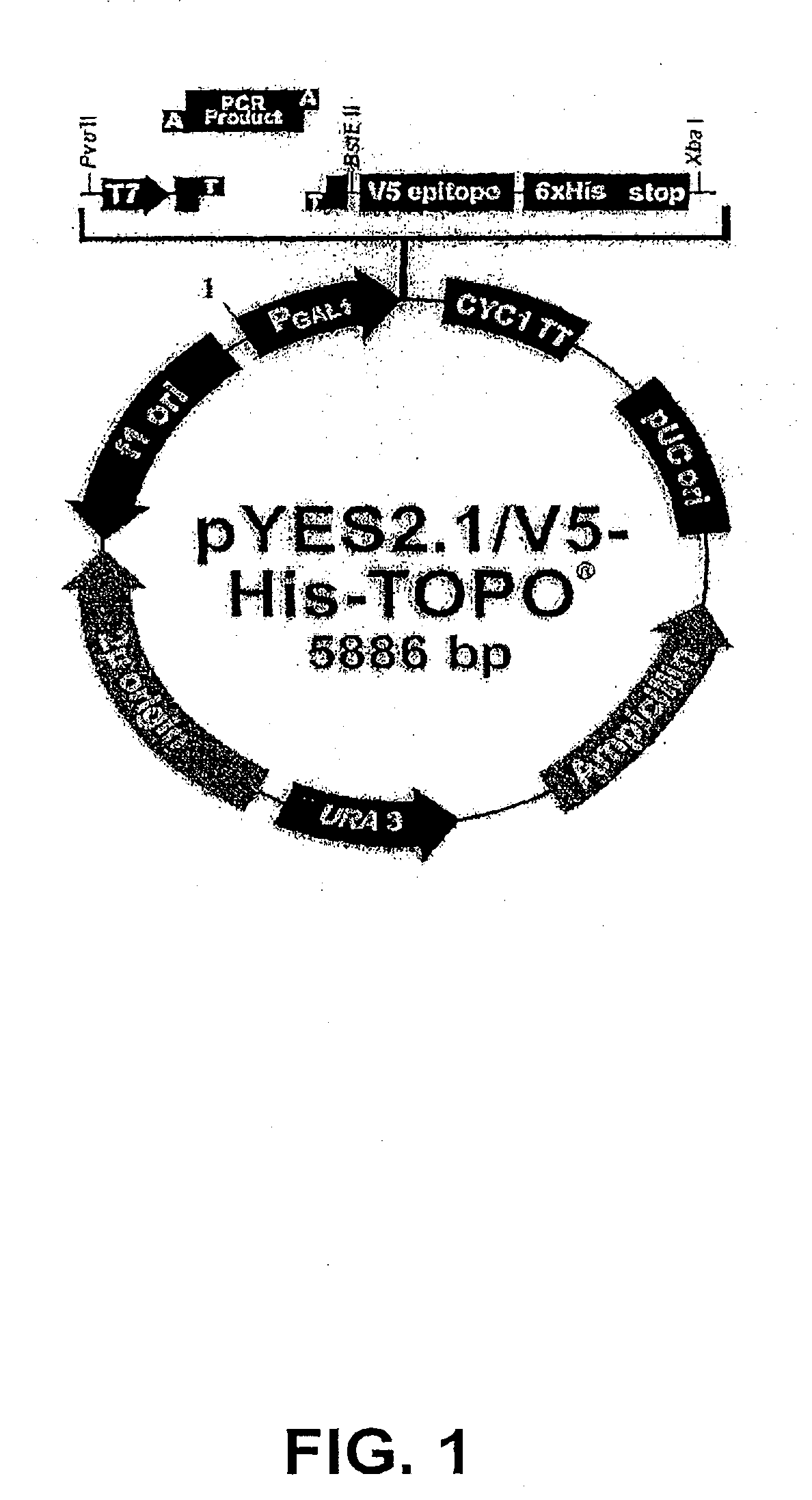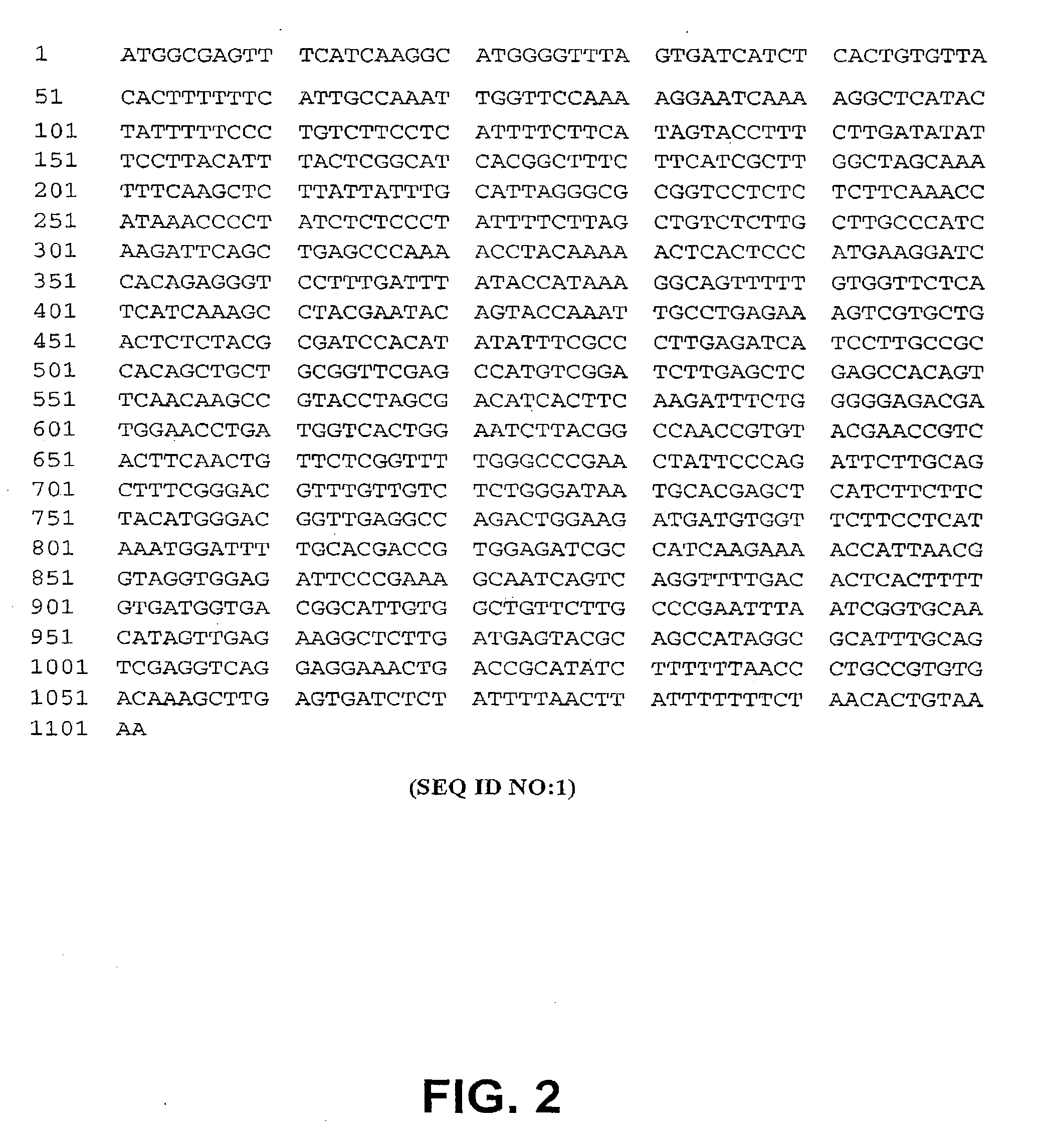Increased Phytosterol Content Through Overexpression of an Acyl-CoA Sterol Acyl-Transferase
a technology of acylcoa sterol and acyltransferase, which is applied in the field of genetic engineering to overexpress an acylcoa sterol acyltransferase, can solve the problems of costly fatty acids used in phytosterol-containing foods, difficult to incorporate free phytosterols into food stuffs, etc., and achieves enhanced cycloartenol levels, cycloartenol-enhancing effects
- Summary
- Abstract
- Description
- Claims
- Application Information
AI Technical Summary
Benefits of technology
Problems solved by technology
Method used
Image
Examples
example i
[0087]The Arabidopsis cDNA corresponding to the gene encoding a sterol acyltransferase, i.e., At3g51970 (FIG. 2), was cloned by RT-PCR using the commercial kit of “SuperScript First-Strand Synthesis System for RT-PCR,” commercially available from Invitrogen. The cDNA was sequenced and inserted into the vector pYES2.1 / V5-His-TOPO® (FIG. 1), commercially available from Invitrogen and used according to the manufacturer's protocol. The vector having the inserted At3g51970 cDNA was transformed into the yeast are1 / are2 mutant using the established procedure of Small-Scale Yeast Transformation as described in the pYES2.1 / V5-His-TOPO® manual from Invitrogen. Neutral lipid extracts of the yeast were subjected to normal-phase HPLC analysis to assay for the production of sterol esters in the yeast. The top panel of FIG. 5 illustrates the production of sterol esters in the yeast transformed with At3g51970, while the vector lacking At3g51970, i.e., pYES2.1, served as a negative control that lack...
example ii
Identification of a Brassica sterol Acyltransferase Gene
[0089]The nucleotide and deduced amino acid sequence information from Arabidopsis is used to search against Brassica genomic, cDNA and / or Expressed Sequence Tag information to identify a sterol acyltransferase gene from other Brassica species, i.e., Brassica napus. In certain other embodiments, the gene and / or the cDNA of At3g51970 is used as a labeled probe to carry out nucleotide hybridization to identify genes encoding sterol acyltransferase. In yet another embodiment, the polypeptide that is produced or generated according to sequence information of At3g51970 is used to generate antibody that is used to screen a cDNA library for a sterol acyltransferase cDNA.
example iii
Transformation of a Plant with Plant Sterol Acyltransferase Gene
[0090]The transformation protocol is adapted from that described by Bechtold et al. (1993). Plants of Arabidopsis thaliana ecotype Columbia are grown in moist soil at a density of ten to twelve plants per pot, in four-inch square pots, and are covered with a nylon screen fixed in place with an elastic band. When the plants reach the stage at which bolts emerge, plants are watered, the bolts and some of the leaves are clipped, and the plants are infiltrated in Agrobacterium suspension as outlined below.
[0091]Agrobacterium transformed with the sterol acyltransferase gene of the instant invention is grown in a 25 mL suspension in LB medium containing kanamycin at a concentration of 50 μg / mL. The Agrobacterium is cultured for two to three days. The day before infiltration, this “seed culture” is added to 400 mL of LB medium containing 50 μg / mL kanamycin. When the absorbance at 600 nm is >2.0, the cells are harvested by cent...
PUM
| Property | Measurement | Unit |
|---|---|---|
| pH | aaaaa | aaaaa |
| concentration | aaaaa | aaaaa |
| optical density | aaaaa | aaaaa |
Abstract
Description
Claims
Application Information
 Login to View More
Login to View More - R&D
- Intellectual Property
- Life Sciences
- Materials
- Tech Scout
- Unparalleled Data Quality
- Higher Quality Content
- 60% Fewer Hallucinations
Browse by: Latest US Patents, China's latest patents, Technical Efficacy Thesaurus, Application Domain, Technology Topic, Popular Technical Reports.
© 2025 PatSnap. All rights reserved.Legal|Privacy policy|Modern Slavery Act Transparency Statement|Sitemap|About US| Contact US: help@patsnap.com



